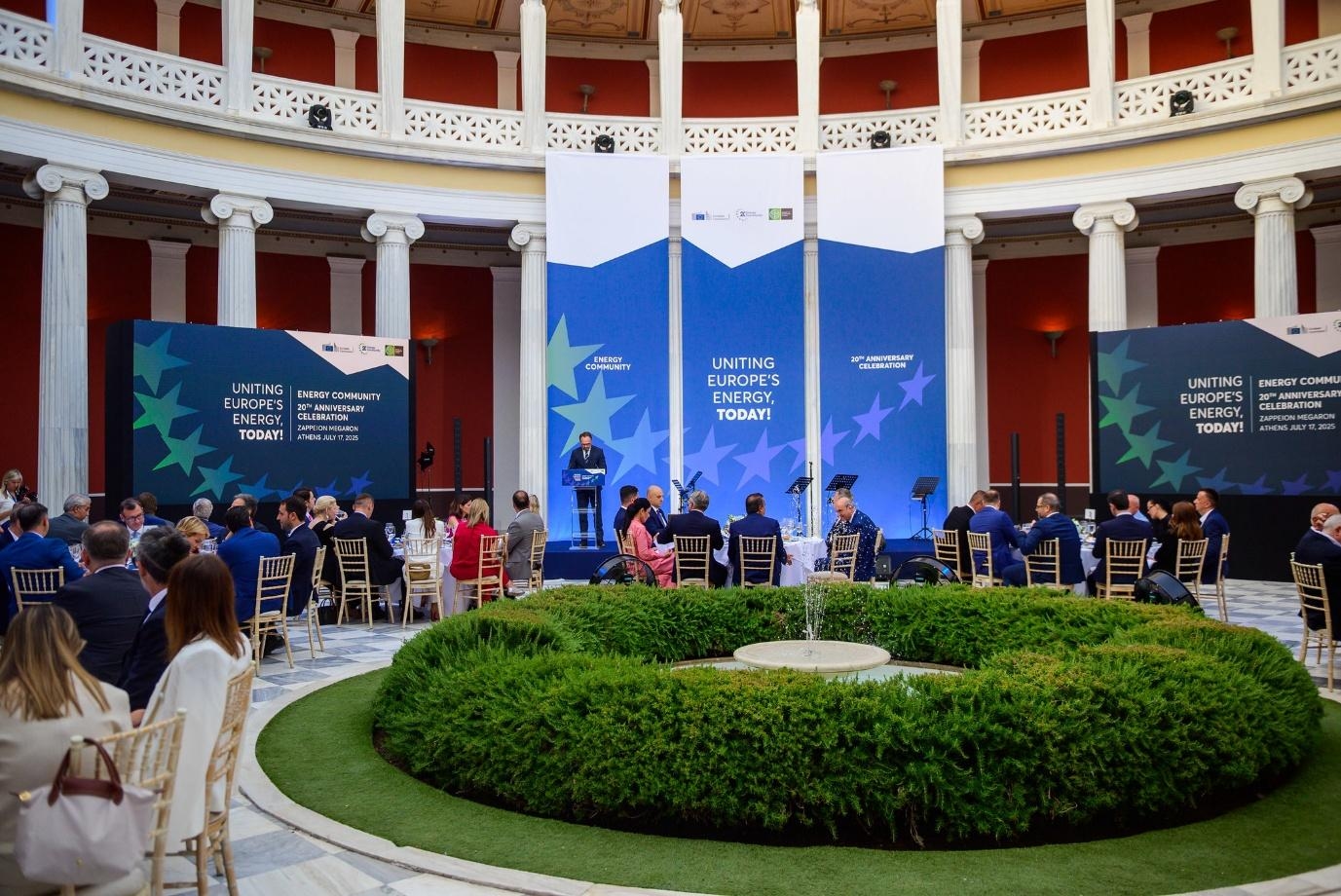Happy 20th Birthday, Energy Community – From Vision to Transformation

It began in Athens, two decades ago, with a signature at the Zappeion Megaron — a city built on ideas giving birth to another one: that energy could unite where politics once divided. The Energy Community was born in 2005 to extend the EU’s energy market beyond its borders, connecting neighbours through common rules, shared goals, and, over time, trust.
Two decades later, the story returned to where it started. This July, the Zappeion opened its doors once again — not for negotiations this time, but for reflection and celebration. Ministers, diplomats, regulators, and former leaders gathered under its arches. Many of them had helped write the Community’s first chapters; others were now steering its future. EU Commissioner Dan Jørgensen spoke of ambition; Greek Minister Stavros Papastavrou of solidarity; and Director Artur Lorkowski of the people whose steady work had kept the Secretariat — the Energy Community’s engine — running for twenty years.
The setting was ceremonial, but the story it marked was anything but static: one of perseverance, adaptation, and a region learning to cooperate through energy even when politics faltered. To understand how far the Energy Community has come, it helps to look back at the journey that brought it here.
The formative years (2005–2009)
The Energy Community came to life in Athens in 2005, when the Treaty was signed at the historic Zappeion Megaron, extending the EU’s energy market beyond its borders. In a region still emerging from the shadows of conflict, it laid the foundation for cooperation, trust, and shared rules where none had existed before. The Secretariat, established in Vienna a year later, became the focal point for turning those rules into reality.

The first Regulatory Board meeting in 2006 brought together regulators, institutionalising the platform for cooperation and coordination. That cooperation meant that, gradually, energy markets began to function more efficiently — an essential step for attracting investment in new infrastructure.
The establishment of the Coordinated Auction Office in 2008 opened the way to efficient cross-border electricity trading. For people, this meant the prospect of more affordable power through interconnections. With the adoption of the EU’s Third Energy Package in 2009, the principles of fair competition and transparent access were embedded, strengthening consumer rights and setting a standard that utilities were obliged to follow.
Growth and integration (2010–2016)Moldova’s accession in 2010 and Ukraine’s in 2011 expanded the Energy Community’s reach dramatically. Millions of citizens in Eastern Europe were now under the same framework of rules that applied in the EU. Over time, this meant energy bills subject to more transparent regulation, more secure supplies, and new opportunities for investors to finance projects in renewables and efficiency.

The 2020 energy and climate targets, adopted in 2012, had been translated into visible changes. Renovated apartment blocks, insulated schools, and the first generation of wind farms and solar plants showed that efficiency and clean energy could reduce costs while opening new industries.
In 2013, the adoption of binding environmental standards addresses emissions from large power plants. For communities living near outdated coal stations, this meant a perspective of cleaner air and measurable health improvements.
The Treaty’s extension in 2014 ensured that reforms would not be interrupted, and Georgia’s accession in 2016 extended the framework into the South Caucasus, anchoring new opportunities for investment and innovation under EU standards.
Urgency and transformation (2017–2025)The last years of the past decade has been marked by crises that tested the Community’s resilience. In 2021, the adoption of the Gas Security of Supply Regulation ensured that, in times of gas shortage, countries could coordinate rather than compete. For citizens, this meant a stronger safety net: heating in winter less vulnerable to the blackmail of the dominant supplier.
That same year, the Decarbonisation Roadmap set a course for climate neutrality by 2050. For young people, it offered a vision that their region could share in Europe’s green and just transition rather than be left behind.
In 2022, integration of the EU’s Clean Energy Package accelerated electricity market alignment, paving the way for competitive cross-border trade.
But it was Russia’s war of aggression against Ukraine that truly underscored the Community’s purpose. In response, the Ukraine Energy Support Fund was created. By now it had mobilised close to EUR 1,2 billion in contributions. The Fund delivered spare parts, transformers, and fuel to keep hospitals running, schools open, and homes heated despite bombardments. For families in Ukraine, this was concrete survival: electricity restored after strikes, intensive care units powered, heating turned back on in the midst of winter.

By 2023, the first National Energy and Climate Plans aligned countries with the EU’s 2030 governance framework and longer-term vision, giving citizens a clearer sense of where their energy future was headed. Another Treaty extension secured continuity, paving the way for deeper integration into the EU’s energy system.
Looking aheadThe Athens anniversary was not a closing chapter but a reminder that the Energy Community’s journey is still in motion. Two decades of cooperation have already brought change that citizens can feel: more reliable electricity, cleaner air, fairer bills, and, in Ukraine, a lifeline in wartime. But the story is far from complete.
The 2024 Implementation Report shows that integration remains uneven: electricity markets are not yet fully integrated with the EU, many large plants continue to pollute above European standards, and gas remains weaponised. These are not shortcomings to lament but tasks to be accomplished in the years ahead.
The next twenty years must deliver on what has been started: full integration with EU energy markets, robust environmental compliance, independent institutions that protect consumers, and a just transition for the vulnerable. Carbon pricing, deeper investment in renewables, and putting efficiency first, in line with National Energy and Climate Plans, will define success.
The Energy Community was built on the belief that market rules, resilience and solidarity could transform a region once marked by division. That mission to unite Europe’s energy today still stands.
ceenergynews




